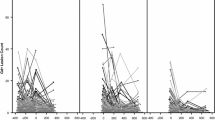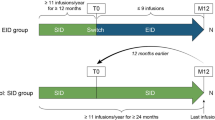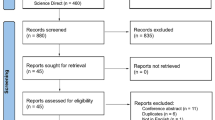Abstract
Natalizumab, a human immunoglobulin monoclonal antibody that targets α4β1/α4β7 integrin, is an effective therapy approved for the treatment of multiple sclerosis (MS). The objective of this analysis was to develop a population exposure–response model utilizing gadolinium-enhancing (Gd) lesion count data from four clinical studies and annualized relapse rate (ARR) data from three clinical studies. The natalizumab exposures were derived for the individuals using a population pharmacokinetic model. A log-linear exposure effect on Gd lesion count and ARR adequately characterized the relationship between exposure and disease response. In the case of the Gd lesion count model, a bimodal model that distributed subjects into two subpopulations based on low or high baseline Gd lesion count provided a superior goodness of fit. The mean (95% confidence interval) slopes from the exposure–Gd lesion count model and exposure-ARR model are −0.0903 (−0.100, −0.081) and −0.0222 (−0.026, −0.015) (mg/L)−1, respectively. From these slopes, it can be inferred that both Gd lesion count and ARR decrease with increasing exposure to natalizumab in MS subjects. Model-based simulations demonstrated that although reductions in Gd lesion count and ARR were observed with lower doses (75, 150, or 200 mg), only the dose of 300 mg every 4 weeks (q4w) was associated with an ARR ≤0.25 and was considered clinically effective. The results from the exposure-Gd lesion count and exposure-ARR models thus support the appropriateness of the approved natalizumab dose (300 mg q4w) in MS subjects.





Similar content being viewed by others
References
National MS Society (2016) What is MS? http://www.nationalmssociety.org/What-is-MS. Accessed 14 October 2016
Tysabri (natalizumab) [prescribing information] (2015) Biogen, Inc., Cambridge
Rudick RA, Sandrock A (2004) Natalizumab: alpha 4-integrin antagonist selective adhesion molecule inhibitors for MS. Expert Rev Neurother 4(4):571–580
Rice GP, Hartung HP, Calabresi PA (2005) Anti-alpha4 integrin therapy for multiple sclerosis: mechanisms and rationale. Neurology 64(8):1336–1342
Miller DH, Khan OA, Sheremata WA, Blumhardt LD, Rice GP, Libonati MA, Willmer-Hulme AJ, Dalton CM, Miszkiel KA, O’Connor PW, International Natalizumab Multiple Sclerosis Trial Group (2003) A controlled trial of natalizumab for relapsing multiple sclerosis. N Engl J Med 348(1):15–23
Polman CH, O’Connor PW, Havrdova E, Hutchinson M, Kappos L, Miller DH, Phillips JT, Lublin FD, Giovannoni G, Wajgt A, Toal M, Lynn F, Panzara MA, Sandrock AW, Investigators AFFIRM (2006) A randomized, placebo-controlled trial of natalizumab for relapsing multiple sclerosis. N Engl J Med 354(9):899–910
Rudick RA, Stuart WH, Calabresi PA, Confavreux C, Galetta SL, Radue EW, Lublin FD, Weinstock-Guttman B, Wynn DR, Lynn F, Panzara MA, Sandrock AW, Investigators SENTINEL (2006) Natalizumab plus interferon beta-1a for relapsing multiple sclerosis. N Engl J Med 354(9):911–923
Trojano M, Ramió-Torrentà L, Grimaldi LME, Lubetzki C, Schippling S, Evans K, Gheuens S, Muralidharan K, Natarajan A, Mikol D (2015) Subcutaneous natalizumab 300 mg every 4 weeks is comparable to standard intravenous dosing in REFINE: a study exploring the safety, tolerability, and efficacy of multiple natalizumab treatment regimens in patients with relapsing multiple sclerosis. Neurology 85(4):e46
Kandadi K, Kuesters G, Subramanyam M, Plavina T, Nestorov I (2016) Population pharmacokinetics (PK) and pharmacodynamics (PD) of natalizumab in patients with multiple sclerosis (MS). In: Presented at the 2016 Annual Meeting of the Population Approach Group in Europe; June 7–10, 2016; Lisbon, Portugal. I-73
Jones P (2011) All about multiple sclerosis. Gadolinium. http://www.mult-sclerosis.org/Gadolinium.html. Accessed 14 October 2016
Lavery AM, Verhey LH, Waldman AT (2014) Outcome measures in relapsing-remitting multiple sclerosis: capturing disability and disease progression in clinical trials. Mult Scler Int 2014:262350
Beal SL, Sheiner LB, Boeckmann AJ, Bauer RJ (2009) NONMEM users guide volumes I-VIII. ICON Development Solutions, Hanover
Albert PS, McFarland HF, Smith ME, Frank JA (1994) Time series for modeling counts from a relapsing-remitting disease: application to modelling disease activity in multiple sclerosis. Stat Med 13:453–466
Altman RM, Petkau AJ (2005) Application of hidden Markov models to multiple sclerosis lesion count data. Stat Med 24:2335–2344
MacKay Altman R, Petkau AJ, Vrecko D, Smith A (2012) A longitudinal model for magnetic resonance imaging lesion count data in multiple sclerosis patients. Stat Med 31:449–469
Velez de Mendizabal N, Hutmacher MM, Troconiz IF, Goñi J, Villoslada P, Bagnato F, Bies RR (2013) Predicting relapsing-remitting dynamics in multiple sclerosis using discrete distribution models: a population approach. PLoS ONE 8(9):e73361
Hang Y, Hu X, Zhang J, Liu S, Deykin A, Nestorov I (2016) Analysis of peginterferon β-1a exposure and Gd-enhanced lesion or T2 lesion response in relapsing-remitting multiple sclerosis patients. J Pharmacokinet Pharmacodyn 43(4):371–383
Plan EL (2014) Modeling and simulation of count data. CPT Pharmacomet Syst Pharmacol 3(8):e129
Lindbom L, Pihlgren P, Jonsson EN (2005) PsN-Toolkit—a collection of computer intensive statistical methods for non-linear mixed effect modeling using NONMEM. Comput Methods Programs Biomed 79(3):241–257
Sormani MP, Bonzano L, Roccatagliata L, Cutter GR, Mancardi GL, Bruzzi P (2009) Magnetic resonance imaging as a potential surrogate for relapses in multiple sclerosis: a meta-analytic approach. Ann Neurol 65(3):268–275
Foley J (2010) Recommendations for the selection, treatment, and management of patients utilizing natalizumab therapy for multiple sclerosis. Am J Manag Care 16(6 Suppl):S178–S183
Foley J, Gudesblatt M, Zarif M, Lathi E (2014) Low body weight as a potential surrogate risk factor for progressive multifocal leukoencephalopathy. Neurology 82(suppl 10):P2.244
Tanaka M, Kinoshita M, Foley JF, Tanaka K, Kira J, Carroll WM (2015) Body weight-based natalizumab treatment in adult subjects with multiple sclerosis. J Neurol 262(3):781–782
Zhovtis Ryerson L, Frohman TC, Foley J, Kister I, Weinstock-Guttman B, Tornatore C, Pandey K, Donnelly S, Pawate S, Bomprezzi R, Smith D, Kolb C, Qureshi S, Okuda D, Kalina J, Rimler Z, Green R, Monson N, Hoyt T, Bradshaw M, Fallon J, Chamot E, Bucello M, Beh S, Cutter G, Major E, Herbert J, Frohman EM (2016) Extended interval dosing of natalizumab in multiple sclerosis. J Neurol Neurosurg Psychiatry 87(8):885–889
Cree B, de Seze J, Fox R, Gold R, Hartung HP, Jeffery D, Kappos L, Kaufman M, Montalban X, Weinstock-Guttman B, Woodworth J, Plavina T, Duda P (2013) Natalizumab effects during a 6-month dose interruption: relationship of pharmacokinetic (PK), pharmacodynamic (PD), and MRI measurements. Neurology 80(Meeting Abstracts 1):S41.003
Fox RJ, Cree BA, de Sèze J, Gold R, Hartung HP, Jeffery D, Kappos L, Kaufman M, Montalbán X, Weinstock-Guttman B, Anderson B, Natarajan A, Ticho B, Duda P, RESTORE (2014) MS disease activity in RESTORE: a randomized 24-week natalizumab treatment interruption study. Neurology 82(17):1491–1498
Acknowledgements
All named authors meet the International Committee of Medical Journal Editors criteria for authorship for this manuscript and take responsibility for the integrity of the work as a whole. Biogen (Cambridge, MA, USA) provided funding for editorial support in the development of this manuscript; Joshua Safran of Ashfield Healthcare Communications (Middletown, CT, USA) copyedited and styled the manuscript per journal requirements. Biogen reviewed and provided feedback on the manuscript to the authors. The authors had full editorial control of the manuscript and provided their final approval of all content. We would like to thank Dr. Yaming Hang and Dr. Xiao Hu on their valuable input on model development and implementation in NONMEM. Partial results from this analysis have previously been presented at the 32nd congress of the European Committee for Treatment & Research in Multiple Sclerosis (ECTRIMS; September 14–17, 2016, London, UK).
Author information
Authors and Affiliations
Contributions
Dr. MS facilitated bioanalytical analysis of serum natalizumab concentration and α4-integrin saturation interpretation of laboratory data and provided access to PK-PD data. Dr. DM facilitated the transfer of MRI and ARR data. KKM and Dr. IN developed and interpreted the PK-PD and exposure–response models. Additional feedback on sections involving clinical interpretation, and discussions were provided by Dr. DM, Dr. P-RH, Dr. DA, Dr. JE and Dr. DS, KKM wrote the manuscript. Dr. IN, Dr. MS, Dr. P-RH, Dr. JE, and Dr. DS approved the final version.
Corresponding author
Ethics declarations
Conflict of interest
This analysis was funded by Biogen. Drs. Muralidharan, Steiner, Ho, Elkins, Subramanyam, and Nesterov are employees of and hold stock and/or stock options in Biogen (Cambridge, MA, USA). Drs. Amarante and Mikol were employees of and held stock and/or stock options in Biogen during completion of this work. Dr. Mikol is now an employee of Amgen; Amgen was not in any way associated with this work.
Ethical approval
All studies were sponsored by Biogen and were conducted in accordance with the principles of the Declaration of Helsinki and the International conference on Harmonization Guideline for Good Clinical Practice.
Informed consent
Written informed consent was obtained from all subjects.
Additional information
Dr. Amarante passed away during the development of this manuscript, and though he qualified for authorship per ICMJE criteria, he was not able to provide final approval. The authors gratefully acknowledge his contributions to the analyses in and development of this manuscript.
Electronic supplementary material
Below is the link to the electronic supplementary material.
Rights and permissions
About this article
Cite this article
Muralidharan, K.K., Steiner, D., Amarante, D. et al. Exposure–disease response analysis of natalizumab in subjects with multiple sclerosis. J Pharmacokinet Pharmacodyn 44, 263–275 (2017). https://doi.org/10.1007/s10928-017-9514-4
Received:
Accepted:
Published:
Issue Date:
DOI: https://doi.org/10.1007/s10928-017-9514-4




